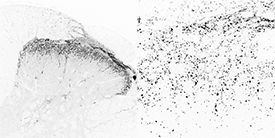Product Details
| Alternative Name: | CGRP |
| |
| Host: | Sheep |
| |
| Immunogen: | Synthetic peptide corresponding to a portion of rat α-calcitonin gene-related peptide (CGRP). |
| |
| UniProt ID: | P01256 |
| |
| Source: | Purified from sheep serum. |
| |
| Species reactivity: | Human, Mouse, Rat
Rabbit
|
| |
| Crossreactivity: | Likely to react with other mammalien species (based on homology, not tested). |
| |
| Applications: | IHC
|
| |
| Purity Detail: | Ammonium sulphate precipitation. |
| |
| Formulation: | Liquid. In PBS containing 0.1% sodium azide. |
| |
| Handling: | Avoid freeze/thaw cycles. |
| |
| Shipping: | Blue Ice |
| |
| Long Term Storage: | -20°C |
| |
| Scientific Background: | Calcitonin gene-related peptide (CGRP) is a 37-amino acid disulphide-bridged sensory neuropeptide present in the central and peripheral nervous systems of many animal species. Two forms of CGRP (α and β) have been identified from both rat and human, and the sequence of chicken CGRP has also been reported, showing striking structural similarity to the mammalian forms. CGRP is abundant in perivascular sensory neurons and is known to be a potent vasodilator. Recent work supports the rôle of CGRP in mediating skin vasodilatation and differential mesenteric artery vasorelaxation, as well as serving as an endogenous myocardial protective substance with a possible involvement in the inhibition of human platelet aggregation. CGRP is frequently co-localised with Substance P and immunoelectron microscopic observations have shown that the peptides are co-stored in single secretory granules both in sensory neurons and in thyroid C-cells. There are many hundreds of reports in the scientific literature describing the localisation and co-existence of CGRP with other transmitter molecules in a vast array of mammalian and non-mammalian species. |
| |
| Technical Info/Product Notes: | Application Data details.
Test tissues: Rat thoracolumbar spinal cord.
Fixatives: Recommended fixative is 4% formaldehyde (prepared from para-polymer) in 0.1M sodium phosphate buffer (pH 7.2-7.4). Perfusion fixation is recommended if possible. |
| |
| Regulatory Status: | RUO - Research Use Only |
| |

Immunohistochemistry analysis: Vibratome (70μm) sections of rat spinal cord immunostained with sheep polyclonal antiserum to CGRP (Prod. No. BML-CA1137) at a dilution of 1:1000. Negative images of fluorescence detection procedure (Alexa488 conjugated secondary antibody). Micrograph courtesy of Professor Andrew Todd (University of Glasgow).
Please mouse over
Product Literature References
Cancer aggravation due to persistent pain signals with the increased expression of pain-related mediators in sensory neurons of tumor-bearing mice: K. Tanaka, et al.; Mol. Brain
16, 19 (2023),
Abstract;
Evidence That a TRPA1-Mediated Murine Model of Temporomandibular Joint Pain Involves NLRP3 Inflammasome Activation: X. Kodji, et al.; Pharmaceuticals
14, 1073 (2021),
Abstract;
Juvenile social defeat stress exposure favors in later onset of irritable bowel syndrome-like symptoms in male mice: K. Matsumoto, et al.; Sci. Rep.
11, 16276 (2021),
Abstract;
Protective Effect of TRPM8 against Indomethacin-Induced Small Intestinal Injury via the Release of Calcitonin Gene-Related Peptide in Mice: A. Fouad, et al.; Biol. Pharm. Bull.
44, 947 (2021),
Abstract;
Teriparatide relieves ovariectomy-induced hyperalgesia in rats, suggesting the involvement of functional regulation in primary sensory neurons by PTH-mediated signaling: T. Tanaka, et al.; Sci. Rep.
10, 5346 (2020),
Abstract;
Full Text
Anti-nerve growth factor therapy attenuates cutaneous hypersensitivity and musculoskeletal discomfort in mice with osteoporosis: M. Suzuki, et al.; Pain Rep.
3, e652 (2018),
Abstract;
Full Text
Immune or Genetic-Mediated Disruption of CASPR2 Causes Pain Hypersensitivity Due to Enhanced Primary Afferent Excitability: J.M. Dawes, et al.; Neuron
97, 806 (2018),
Abstract;
Full Text
Tumor-promoting cyanotoxin microcystin-LR does not induce procarcinogenic events in adult human liver stem cells: J. Raska, et al.; Toxicol. Appl. Pharmacol.
345, 103 (2018),
Abstract;
Localized experimental bone metastasis drives osteolysis and sensory hypersensitivity at distant non-tumor-bearing sites: D.M. Abdelaziz, et al.; Breast Cancer Res. Treat.
153, 9 (2015),
Abstract;
Deletion of ENTPD3 does not impair nucleotide hydrolysis in primary somatosensory neurons or spinal cord: E. McCoy, et al.; F1000Res
3, 163 (2014),
Abstract;
Full Text












